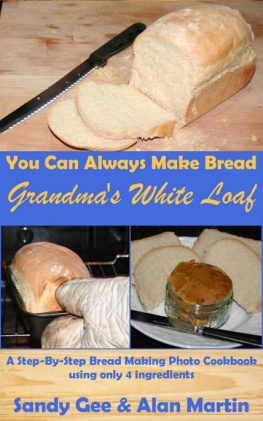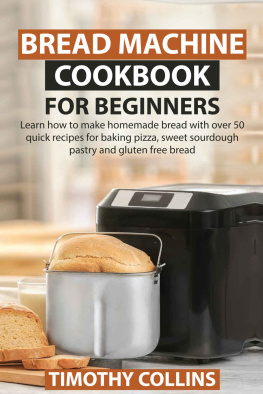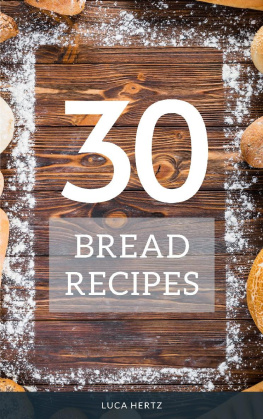For Tracy, and everyone who thinks they cant bake .
Acknowledgements
The You Can Always Make series was inspired by several different people, all of whom deserve a mention here.
Thanks go first to Mrs Webster, my class 10 teacher in middle school, who always said, Explain it to me like Im an alien who just landed on Earth. Second, to Sue Mellish and her teenage kids, whose debate about how to make coffee without a microwave will live in my memory forever, and makes me smile every time I think about it. Finally to Tracy Hudson, whose cultivated ineptitude in the kitchen provided the final spark. Theres no excuse now, Tracy.
I also have to thank James Jones, John S. Rhodes, Jay Boyer and Matt Rhodes for their excellent Forbidden Kindle training, which helped me get from the germ of an idea to a published series.
Huge thanks go to my regular proofreading, copy editing, reading and cheerleading team Dawn Robinson, Maryanne Collinson, Ren Smith, Martha Picanso Rezpala and Julie Zapotezny, and to all the people who have helped with likes, comments and feedback on my Facebook pages and Twitter feeds.
I have to thank my mum for teaching me how to bake and my dad for being prepared to ea t some of my earliest creations. Without you both, I would never have had the confidence to write a single book, let alone embark on a whole series.
Thanks go also to Gary Mcmullen for lending me your pastry chef experience and expertise, and showing me some of the tricks of the trade to ensure a perfect white loaf every time.
This section wouldnt be complete without a nod to all the Gable-enders, past and present who continue to support me and show an active interest in my work. So thanks to Tracy, Derek, Lauren, Jade, Rob, Gary, Gaby, Tina, Chris and Glen. Youre all stars, and some of the best friends its been my honour to make.
A big thank you to Millie, Becky, Jack and Lewis for being willing taste testers and providing feedback as only hungry teenagers can.
Finally, the biggest thank you of all has to be reserved for Alan M artin, without whose input this book would still be a half-finished project on my hard drive. Im looking forward to working on the You Can Always Make series with you. Heres to the adventure.
Preface ( You Can Always Make.com)
I love recipe books. I can flick through them for hours, looking for inspiration. There are, however, some things about most cookbooks that drive me mad.
I hate recipes without a photo of the end result. How do I know Ive got it right if theres nothing to compare my efforts to?
Also, Im a detail person, so recipes that skimp on the descriptions and instructions annoy me. If a recipe calls for an unusual ingredient, I want to know a little about it and where to get it. If possible, I want suggestions for substitutions, just in case that elusive ingredient isnt available local to me.
I dont just want to know what ingredients Ill need, either. I want to know which equipment and utensils are required, before I start. Reading instruction like strain through a muslin cloth half way through a recipe, when I dont have one, make my blood boil. Also, if there are tricky techniques involved, I need to know how to do them, preferably with more photos.
Finally, I want my recipes to be as international as possible. If the author uses an imperial or volume measuring system, I need to know whether its an American cup (1/2 a US pint or 8 US fluid ounces) or a European cup (240 millilitres.) Similarly, an ingredient had different names, such as All Purpose (AP) flour in the US and plain flour in the UK, its nice to have a heads up, instead of having to go search for the information.
Thats the inspiration for the You Can Always Make series. Recipes that tell you everything you need to know to complete them, assuming no prior knowledge or experience. The recipes have been researched and adapted from a wide variety of sources, to figure out which elements of the recipe are fundamental, and which are optional.
Theyve been tested by Sandy first, to devise the instructions, and then followed by Alan to ensure the instructions are easy to follow. Only then have we photographed each stage of the recipe and compiled the books.
The end result is a series of step-by-step photo guides to recipes that anyone should be able to follow. Theyre great for kids, although of course adult supervision is required. Theyre also ideal for students away from home for the first time and learning to fend for themselves, and for anyone who finds the kitchen a challenge.
While some recipes may include advanced techniques and equipment, the Basic series is just that basic. The recipes included in this range require minimal ingredients, most of which are store cupboard staples and use only equipment you should find in any kitchen.
Essential, recommended and optional ingredients and stages are clearly marked as such. Leaving out recommended ingredients might alter the end result, but wont cause the recipe to fail. Where optional ingredients are included, theres also an explanation of why you might want to use them.
The recipes also include metric (which remains the same worldwide, and therefore is used as the base measurement) European imperial and US by volume measurements, which should keep just about everyone happy. Tools and equipment are generally described using UK terms. Where possible US equivalents are included, or where the US description is more self-explanatory (as in a dish towel rather than a tea towel) weve deferred to the US term.
We suggest you try your hand at some of these basic recipes and practice the simple techniques included in them before moving on to more advanced creations.
Basic White Bread
You cant beat the smell of bread fresh from the oven, and theres an undeniable sense of achievement the first time you pull out a perfect loaf that youve made from scratch yourself.
Homemade bread tastes better than shop bought, too. Plus, you have the advantage of knowing exactly whats gone into it.
This basic white bread recipe uses only four ingredients, flour, salt, yeast and water. While you can add oils, butter, milk and other things to the dough, and use milk or egg to glaze the crust, none of those are necessary to create a perfect white loaf with a gorgeous crunchy golden crust.
If youre in a hurry and just want to know what to do, simply follow the step by step photo instructions. If you want to learn more about the ingredients and methods, and understand why you need strong white flour, or why you need to knead the dough for so long, read through the steps before you start, or as you go along.









